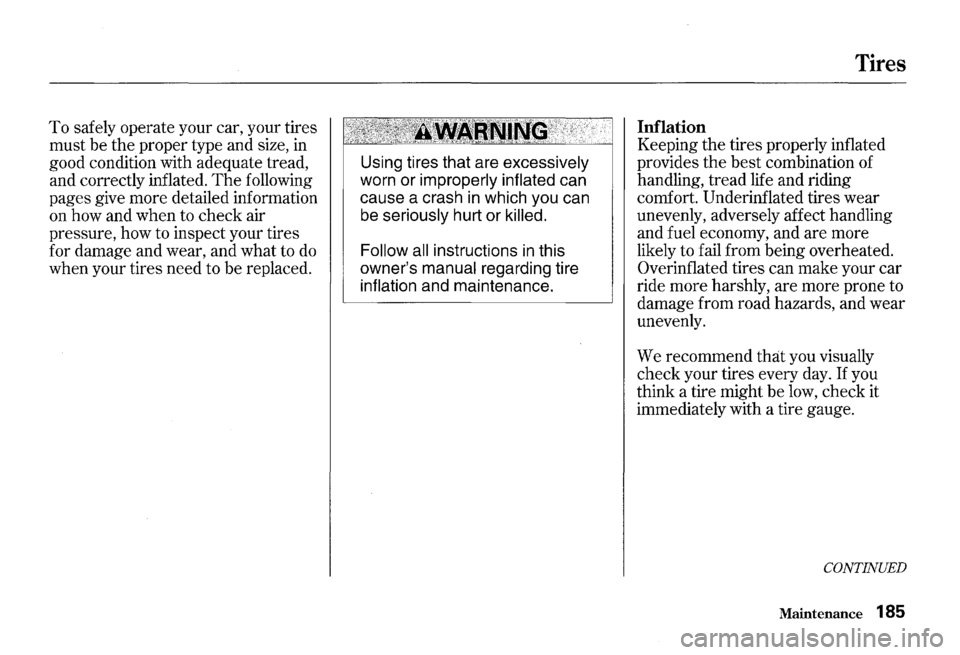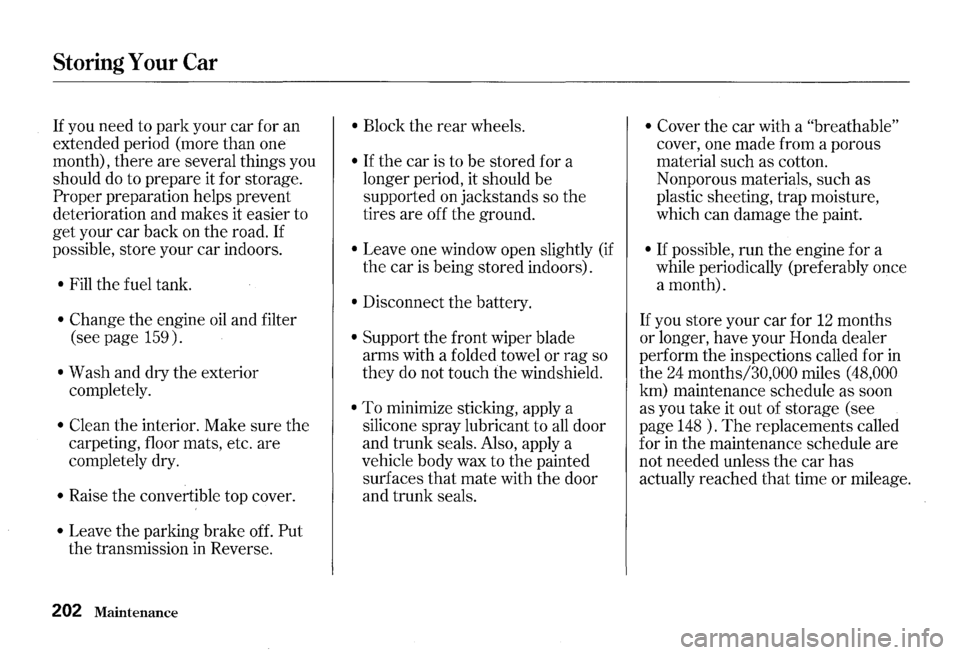2000 HONDA S2000 fuel
[x] Cancel search: fuelPage 154 of 273

Use this schedule if your vehicle is MAINLY driven in any of the following Severe Conditions, or normally driven in Canada; otherwise use the Normal Schedule. Service at the indicated distance or time, whichever comes first. Do the items in A, B, C, D as required for each distance/time.
3,750 mi/6,000 km/6 mos Do items in A. 7,500 mi/12,000 km/- Do items in A, B. 11,250 mi/18,000 km/-
Do items in A. 15,000 mi/24,000 km/1 yr Do items in A, B, C. 18,750 mi/30,000 km/- Do items in A. 22,500 mi/36,000 km/1% yrs Do items_in_A,Jt .. ~--------· ---~~---26,250 mi/42,000 km/-Do items in A. 30,000 mi/48,000 km/2 vrs Do items in A, B, C, D. 33,750 mi/54,000 km/-
Do items in A. 37,500 mi/60,000 km/2'/z vrs
Do items in A, B. 41,250 mi/66,000 km/-
Do items in A. 45,000 mi/72,000 km/3 yrs DReplace brake fluid. DReplace coolant. Do items in A, B, C. 48,750 mi/78,000 km/- Do items in A. 52,500 mi/84,000 km/3'/z vrs Do items in A, B. 56,250 mi/90,000 km/-
Do items in A. 60,000 mi/96,000 km/4 vrs _Do items in A, B, C, D. 63,750 mi/102,000 km/-
Do items in A. 67,500 mi/108,000 km/41!2 yrs Do items in A, B. 71,250 mi/114,000 km/-
Do items in A. 75,000 mi/120,000 km/5 yrs ']Replace coolant. Do itefY!S_lll_ A,_B_,_(:, -~--~--78,750 mi/126,000 km/-
Do items in A.
Note: • Check engine oil and coolant at each fuel stop. • Check and adjust valve clearance, cold engine, if noisy.
·--~
··-
Severe Conditions:
A
B
c
Driving less than 5 mi (8 km) per trip or, in freezing
temperatures, driving less than 10 mi (16 km) per trip.
Driving in extremely hot (over 90°F/32°C) conditions.
Extensive idling or long periods of stop-and-go driving. Driving in mountainous conditions.
Drivin_gon muddy, dusty, or de-iced roads.
[]Replace enqine oil and filter. Dlnspect front and rear brakes. DC heck tire inflation and condition. Dlnspect tie rod ends, steering gear box and boots. Dlnspect suspension components. Dlnspect driveshaft boots. ORe place air cleaner element. ']Check parking brake adjustment. ']Lubricate all hinges, locks and latches. ']Replace rear differential fluid.
CONTINUED
Maintenance 151
Page 155 of 273

82,500 mi/132,000 km/51/z vrs Do items in A, B. 86,250 mi/138,000 km/-Do items in A. 90,000 mi/144,000 km/6 yrs ORe place brake fluid. Do items in A, B, C, D. 93,750 mi/150,000 km/-Do items in A. 97,500 mi/156,000 km/61/z yrs Do items in A. B. 101,250 mi/162,000 km/-Do items in A. 105,000 mi/168,000 km/7 yrs Dlnspect valve clearance. DReplace coolant. Dlnspect idle speed. DReplace spark plugs. Do items in A, B, C. 108,750 mi/174,000 km/-Do items in A. 112,500 mi/180,000 km/71/z yrs Do items in A, B. 116,250 mi/186,000 km/-Do items in A. 120,000 mi/192,000 km/8 vrs Do items in A, B, C D.
152 Maintenance
C Dlnspect brake hoses and lines (including ABS). DC heck all fluid levels, condition of fluids, and check for leaks. Dlnspect cooling system hoses and connections. D"lnspect exhaust system. D"lnspect fuel lines and connections. DCheck all lights and controls. Dlnspect the underbody.
D Dlnspect drive belt. DReplace transmission fluid. DReplace air conditioning filter. # : See information on maintenance and emissions warranty, last column, page 147. * 1: Refer to page183 for replacement information under special driving conditions.
Page 158 of 273

You should check the following
items at the specified intervals.
If
you are unsure of how to perform
any check, turn to the page given.
• Engine oil level -Check every
time you
fill the fuel tank. See
page 119.
• Engine coolant level -Check the
radiator reserve tank every time
you
fill the fuel tank. See page 120 .
• Windshield washer fluid -Check
the level in the reservoir monthly.
If weather conditions cause you to
use the washers frequently, check
the reservoir each time you stop
forfuel. See page 167.
• Brakes and clutch -Check the
fluid level monthly. See page
170 .
Owner Maintenance Checks
• Tires -Check the tire pressure
monthly. Examine the tread for
wear and foreign objects. See page
186.
• Lights -Check the operation of
the headlights, parking lights,
taillights, high-mount brake light,
turn signals, brake lights, and
license plate lights monthly. See
page 192.
Maintenance 155
Page 160 of 273

Adding Oil
To add oil, unscrew and remove the
engine oil fill cap on top of the left
valve cover.
Pour in the oil, and
replace
the engine oil fill cap.
Tighten it securely. Wait a few
minutes and
recheck the oil level. Do
not
fill above the upper mark; you
could damage the engine.
Recommended Oil
Oil is a major contributor to your
engine's performance and longevity.
Always use a premium-grade deter
gent
oil. It is highly recommended
that you use Genuine Honda Motor
oil in your vehicle for as long as you
own it.
You can determine an oil's
SAE
viscosity and Service Classification
from
the API Service label on the oil
container.
A fuel-efficient oil is recommended
for your Honda.
This is shown on the
API Service label by the words
"Energy Conserving." This oil is
formulated to help your engine use
less fuel.
Engine Oil
The API Service label also tells you
the service classification of the oil.
Always use an oil that is labeled "API
Service SJ." This service rating may
include other classifications, such as
CD. These additional classifications
are not a problem, as long as the
label also carries
the SJ classification.
CONTINUED
Maintenance 15 7
Page 161 of 273

Engine Oil
The oil container may also display
the
API Certification seal. Make sure
it says
"For Gasoline Engines."
158 Maintenance
The SAE numbers tell you the oil's
viscosity or weight. Select the
oil for
your car according to this chart.
60
. 10 20
" ~ c" ' -c '
AnlbielltTertlperature
An oil with a viscosity of lOW-30 is
preferred for improved fuel economy
and year-round protection in your
Honda.
You may use a 5W-40 oil if
the temperature in your area goes
below oaF (
-20°C).
Synthetic Oil
You may use a synthetic motor oil if
it meets the same requirements
given for conventional motor
oil:
energy conserving, a service
classification of
SJ, and the proper
weight as shown on the chart. When
using synthetic
oil, you must follow
the
oil and filter change intervals
given
in the maintenance schedule.
Additives
Your Honda does not need any oil
additives. Purchasing additives for
the engine or transmission will not
increase your car's performance or
longevity.
It only increases the cost
of operating your car.
Page 170 of 273

Check the level in the windshield
washer reservoir at least monthly
during normal usage. In bad weather,
when you use the washers often,
check the level every time you stop
for fuel.
The windshield washer reservoir is
located
in the rear of the engine
compartment on the passenger's side. Check
the reservoir's fluid level by
removing the cap and looking at the
level gauge attached to the cap.
Windshield Washers
Fill the reservoir with a good-quality
windshield washer fluid. This
increases the cleaning capability and
prevents freezing
in cold weather.
When you refill the reservoir, clean
the edges of
the windshield wiper
blades with windshield washer fluid
on a clean cloth. This will help to
condition
the blade edges.
NOTICE
Do not use engine antifreeze or a
vinegar/water solution
in the
windshield washer reservoir.
Antifreeze can damage your car's paint,
while a vinegar/water solution can
damage the windshield washer pump.
Use only commercially-available
windshield washer fluid.
Maintenance 167
Page 188 of 273

To safely operate your car, your tires
must be
the proper type and size, in
good condition with adequate tread,
and correctly inflated.
The following
pages give more detailed information
on how and when to check air
pressure, how to inspect your tires
for damage and wear, and what to
do
when your tires need to be replaced.
Using tires that are excessively
worn or improperly inflated can
cause a crash
in which you can
be
seriously hurt or killed.
Follow all
instructions in this
owner's
manual regarding tire
inflation and maintenance.
Tires
Inflation
Keeping the tires properly inflated
provides the
best combination of
handling, tread life and riding
comfort. Underinflated tires wear
unevenly, adversely affect handling
and fuel economy, and are more
likely to fail from being overheated.
Overinflated tires can make your car
ride more harshly, are more prone to
damage from road hazards, and wear
unevenly.
We recommend that you visually
check your tires every day.
If you
think a tire might be
low, check it
immediately with a tire gauge.
CONTINUED
Maintenance 185
Page 205 of 273

Storing Your Car
If you need to park your car for an
extended period (more than one
month), there are several things you
should
do to prepare it for storage.
Proper preparation helps prevent
deterioration and makes it easier to
get your car back on the road.
If
possible, store your car indoors.
• Fill the fuel tank.
• Change the engine oil and filter
(see page 159).
• Wash and dry the exterior
completely.
• Clean the interior. Make sure the
carpeting, floor mats, etc. are
completely dry.
• Raise the convertible top cover.
• Leave the parking brake off. Put
the transmission in Reverse.
202 Maintenance
• Block the rear wheels.
• If the car is to be stored for a
longer period, it should be
supported on jackstands so the
tires are off the ground.
• Leave one window open slightly (if
the car is being stored indoors).
• Disconnect the battery.
• Support the front wiper blade
arms with a folded towel or rag so
they
do not touch the windshield.
• To minimize sticking, apply a
silicone spray lubricant to
all door
and trunk seals. Also, apply a
vehicle body wax to the painted
surfaces that mate with the door
and trunk seals.
• Cover the car with a "breathable"
cover, one made from a porous
material such as cotton.
Nonporous materials, such as
plastic sheeting, trap moisture,
which can damage
the paint.
• If possible, run the engine for a
while periodically (preferably once
a month).
If you store your car for 12 months
or longer, have your Honda dealer
perform the inspections called for
in
the 24 months/30,000 miles (48,000
km) maintenance schedule as soon
as you take it out of storage (see
page
148 ). The replacements called
for
in the maintenance schedule are
not needed unless the car has
actually reached that time or mileage.